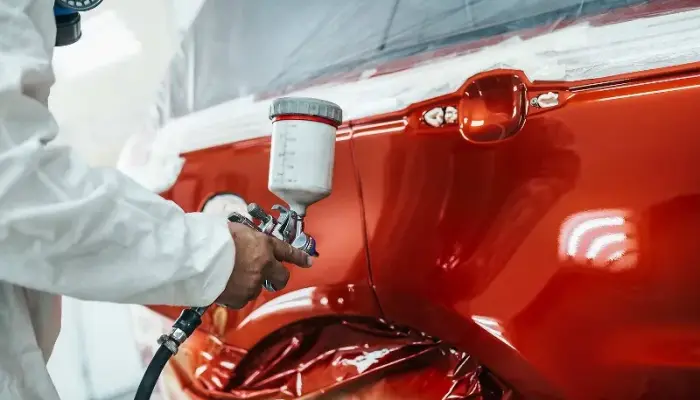Repairing and painting car parts is a responsible process that requires special knowledge and skills. The quality of the coating depends directly on how correctly and carefully each stage of the work is performed. This article examines in detail all the key stages of repairing and painting car parts.
Surface Preparation
Surface preparation is one of the most important stages before painting. The cleanliness and roughness of the surface determine how well the paint will adhere and how long the coating will last.
Various methods are used to remove old coatings and rust, depending on the type of material and the degree of surface damage. For example, high-pressure sandblasting allows deep cleaning of the surface from rust and paint. Chemical etching is used for light contamination. Manual cleaning with a stiff metal brush is also effective but requires effort.
Special solvents, such as white spirit, are used for degreasing. They remove grease, oils, and other contaminants from the surface, preventing them from causing paint to peel off in the future.
An essential stage is surface sanding. Abrasive wheels or sandpaper make the surface rough, allowing the paint to adhere better to the base. Coarse sandpaper is used first, followed by finer sandpaper for a perfectly smooth result.
Puttying and Priming
Puttying is necessary for leveling the surface, filling scratches, and unevenness. Special polyester putties for cars are used. They are applied in layers with a spatula, and after each layer dries, they are sanded to achieve a perfectly smooth surface. The number of layers depends on the depth of defects.
Next, apply primer, which provides better paint adhesion and protects the metal from corrosion. There are different types of primers for specific surfaces. For example, special plastic primers are used for plastic surfaces.
Primer helps to identify even small defects and irregularities, which can then be additionally puttied and polished before final painting.
Painting
The painting stage is one of the most crucial. The durability and appearance of the coating depend on the correct choice of paint and application technique.
There is a wide selection of automotive paints, from simple one-component to high-solids two-component paints. Two-component paints, providing the best quality coating, are more commonly used for professional painting.
Before applying the paint, it is thoroughly mixed and thinned to the required viscosity. The exact ratio of components is observed according to the instructions.
Apply the paint in 2-3 thin layers. Each subsequent layer should be thinner than the previous one. The thickness of the coating is monitored using a special thickness gauge. Interlayer drying ensures good curing and adhesion of the layers.
Paint is applied using a spray gun, which allows for an evenly smooth coating. High-quality brushes and rollers are also used. The choice of tool depends on the part being painted.
Polishing
Polishing gives the coating a mirror-like shine and additional protection against mechanical damage and environmental influences.
First, coarse polishing pastes are used to remove minor defects and irregularities. Then increasingly finer abrasives are used to achieve a perfectly smooth surface.
The final stage is applying polishing wax or special diamond paste. This creates an opti-coat coating with a unique shine.
Polishing is carried out in several stages, carefully following the technology. This allows achieving an excellent result - the surface after polishing looks like new!
These are the main stages of repairing and painting car parts. By following this technology and using high-quality materials, you can achieve perfect results - the part looks like new! And with good tools and skills, the process becomes even more enjoyable.
